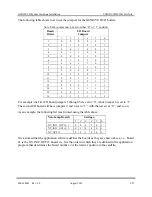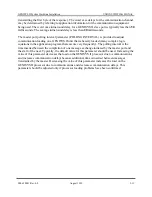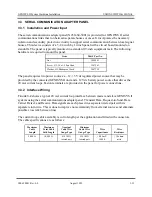
GENISYS II System Hardware Installation
UNION SWITCH & SIGNAL
SM-6900B Rev. 0.0
August 1999
3-3
signals are balanced or unbalanced with respect to signal common, and whether outputs can be
set to a high impedance state for compatibility with multi-drop communication circuits. These
hardware interface standards have no bearing on the protocols or data that may be passed through
these ports. Any of the four serial ports may be used to pass any of the protocols currently
supported by GENISYS II. The only restriction is that ports must connect to external ports that
support a like-hardware standard. RS-485 ports can be connected to RS-485 or RS-422
compatible ports, RS-423 ports can be connected to RS-423 compatible ports, and RS-232 ports
can be connected to RS-232 compatible ports. RS-232 and RS-423 ports can usually be
interconnected.
Typically, the RS-485 serial ports are reserved for direct, local connections between two or more
RS-485 capable units located in the same equipment facility and powered by the same battery
power supply. The RS-485 ports utilize balanced signal drivers and receivers that offer a high
degree of immunity to ambient electrical noise. In addition, RS-485 serial ports may be connected
directly to a multi-drop, hard-wired, serial communication circuit without the use of external
signal processing hardware (signal splitters, etc.). The allowable length of the communication
circuit is essentially unlimited, as long as no part of the circuit leaves the equipment room or
signal house where it originates. (GENISYS II RS-485 circuits cannot be run between signal
houses without serial communication circuit isolation hardware.) RS-423 and RS-232 serial ports
are most easily connected to common serial devices and commercially available modems. The
RS-423 port may be used in simple, short distance, multi-drop applications while the RS-232
port may be used only in short distance (less than 50 feet) point-to-point applications. The RS-
423 port is normally reserved for direct connections to other RS-423 devices such as
MICROTRAX EOS, when required. The RS-232 port is normally reserved for use as a
GENISYS protocol slave port, to be employed as a serial interface to a central control office
when such an interface is required.
Serial devices are generally identified as DTE (Dataline Terminating Equipment) or DCE (Data
Carrying Equipment). In DCE equipment, transmit data (TXD) and request to send (RTS) are
inputs and receive data (RXD) and data carrier detect (DCD) are outputs. Modems are generally
DCE devices. All GENISYS II serial ports are labeled as DTE or terminal devices. This means
that transmit data (TXD) and request to send (RTS) signals are outputs and receive data (RXD),
data carrier detect (DCD), and clear to send (CTS) are inputs. When connecting DTE devices to
DCE devices (when connecting a GENISYS II serial port to a modem, for example) it is
necessary to connect TXD to TXD, RTS to RTS, RXD to RXD, and DCD to DCD.
To establish a useable, direct, bi-directional connection between two GENISYS II serial ports
(both DTE devices), TXD and RXD signals and signal common (COM) must always be
connected. The serial port assigned to this connection on one of the two units must be designated
as the master port and the serial port assigned on the other unit must be designated as a slave. (A
GENISYS protocol communication link may have multiple slaves but it may have only one
master unit.) The ports assigned to this connection must be set to the same protocol (GENISYS).
The data transmitter (TXD) on the master unit must be connected to the data receiver (RXD) on
the slave unit(s). Likewise, RXD on the master unit is connected to TXD on the slave unit(s). The
signal common (COM) for master and slave units are connected together. This connection is the
Summary of Contents for GENISYS II
Page 4: ......
Page 6: ...GENISYS II System Hardware Installation UNION SWITCH SIGNAL 1 2 August 1999 SM 6900B Rev 0 0 ...
Page 12: ...UNION SWITCH SIGNAL GENISYS II System Hardware Installation 2 ii August 1999 SM 6900B Rev 0 0 ...
Page 38: ...UNION SWITCH SIGNAL GENISYS II System Hardware Installation 2 26 August 1999 SM 6900B Rev 0 0 ...
Page 40: ...UNION SWITCH SIGNAL GENISYS II System Hardware Installation 3 ii August 1999 SM 6900B Rev 0 0 ...
Page 60: ...UNION SWITCH SIGNAL GENISYS II System Hardware Installation 3 20 August 1999 SM 6900B Rev 0 0 ...
Page 62: ...UNION SWITCH SIGNAL GENISYS II System Hardware Installation 4 ii August 1999 SM 6900B Rev 0 0 ...
Page 66: ...UNION SWITCH SIGNAL GENISYS II System Hardware Installation 4 4 August 1999 SM 6900B Rev 0 0 ...
Page 67: ......
















































